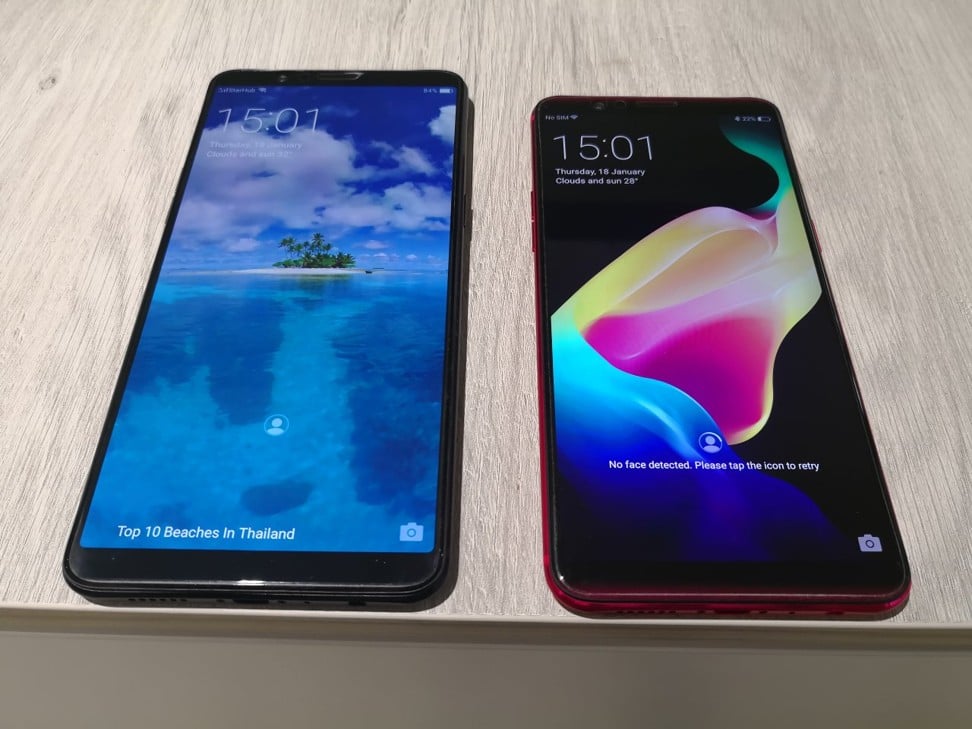
Review | Oppo R11s and R11s Plus full review – face recognition login, improved fingerprint sensor as handsets ape Apple iPhoneX
Chinese manufacturer’s new handsets are attractively priced and have bezel-less design and other features seen on iPhone X, but lack of a processor update means that existing owners of the R11 are unlikely to make the switch
The Chinese electronics firm may be continuing its relentless quest of mimicking Apple’s latest and greatest, but is it worth the upgrade?
Oppo lifts the curtain on its latest Apple, Samsung killer – its R11 smartphone series
Design and hardware
The first thing that strikes you with the new R11s family is the new bezel-less design. Gone is the familiar front-facing fingerprint reader, which has been vanquished to the back for a larger display and a high screen-to-body ratio. In effect, the R11s is a 6-inch smartphone while the R11s Plus is the R11 Plus with a larger 6.4-inch screen.
Elsewhere, both devices sport a gorgeous AMOLED screen, sleek aluminium curves, and a beefed-up dual camera.
One change that stands out is the incorporation of a slightly elongated fingerprint reader on the back, which was a minor but practical tweak that makes it noticeably easier to scan one’s finger. The company has also opted for a thicker colour-matched antenna line along the top and bottom, versus the two slim lines of their predecessors.

Core capabilities remain unchanged, such as the Qualcomm Snapdragon 660 processor, factory-installed screen protector, and dual-SIM support with option to sacrifice one slot for an addition 256GB of microSD storage. This includes limitations such as the absence of NFC hardware, and the now annoying use of micro-USB connector for the company’s VOCC quick-charging technology.
Software and features
Both the R11S and R11S Plus come with Oppo’s ColorOS 3.2, which is based on 7.2 Nougat. ColorOS continues to aggressively mimic the user interface of Apple’s iOS, such as swapping up to bring up a quick setting panel and swapping down to bring up the notification panel.
Likely inspired by the recently released iPhone X, Oppo went further this time by offering what it calls “virtual navigation keys” that let you remove the Android navigation bar entirely.

The latest version of ColorOS retains a host of nifty features not installed by default in most smartphones, such as the ability to automatically record selected (or all) phone calls, or the ability to separately encrypt or lock individual apps. A graphics acceleration mode also promises increased frame rate of up to 60 frames per second and will rev up the processor for better performance when playing games.
Unlike my experience with the Oppo R11, however, the ability to set your default launcher is still under development for the R11s. Oppo says that this is being worked on and will be available in the next software update.
Apple’s iPhone 7 Plus was the second-best selling phone in China in 2017
Performance and battery life
While Oppo ranks among the top contenders in terms of fast recognition of its fingerprint sensors, the R11s family adds a new ace in the pack to authenticate you faster: facial recognition. The system relies on Oppo’s face recognition technology to identify 128 facial features points, match them, and unlock the device in less time than it takes for the screen to come on.
While I was unable to perform extensive tests to verify just how secure the system is, this offered a seamless login experience in practice, especially with “Raise to wake up” enabled – the smartphone automatically identified me and is ready for use as I lift it off the table.
Unlike Apple’s Face ID with its 30,000 infrared dots to capture your face, Oppo relies on its front camera to do the work. This means that performance may vary in extremely bright or dim environments, though well-lit locations such as the office or restaurants were no issues.

The battery stamina was also exceptional, courtesy of the energy-sipping Snapdragon 660 and aggressive battery management mode. I encountered some problems with some productivity apps such as the excellent BlackBerry Hub software due to the latter, though selectively disabling the power saving settings resolved some of the issues I encountered.
The larger screen of the R11s does mean that it consumes more power than the R11, though it is unlikely to be noticeable in everyday use. And of course, the company’s flash charging system will recharge your device in no time at all.
A malicious link being sent around will freeze your iPhone – even if you don’t click on it
Conclusion
The Oppo R11s and R11s Plus are well-built and integrated smartphones that continue the legacy of the brand. The addition of bezel-less design, face recognition and upgraded fingerprint sensor makes for a compelling smartphone with highly competitive specifications and price point against the top-tier flagships. However, the lack of a processor update means that most existing owners of an R11 are unlikely to make the switch.
Dimensions: 155.1mm x 75.5mm x 7.1mm / 164.8mm x 80.2mm x 7.3mm
Weight: 153 grams / 182 grams
Display: 6.01 inches / 6.43 inches
Battery: 3205 mAh / 4000 mAh
OS version reviewed: ColorOS 3.2 based on Android 7.1
Processor: Snapdragon 660
Cameras: (back) 20MP (f/1.7) + 16MP (f/1.7); (front) 20MP (f/2.0)
Memory: 64GB storage. 4GB RAM (6GB RAM for R11s Plus)
Colours: Black, Champagne and Red (R11s only)
Price: R11s (black and gold) US$470; US$500 for red; R11s Plus (black and gold) US$575

